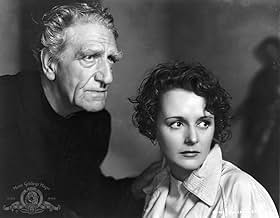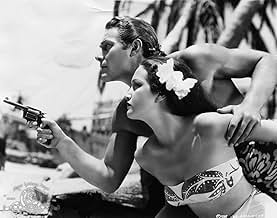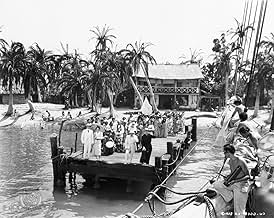IMDb रेटिंग
7.1/10
3.2 हज़ार
आपकी रेटिंग
अपनी भाषा में प्लॉट जोड़ेंA Polynesian sailor unjustly imprisoned after defending himself against a colonial bully is relentlessly persecuted by his island's martinet French governor.A Polynesian sailor unjustly imprisoned after defending himself against a colonial bully is relentlessly persecuted by his island's martinet French governor.A Polynesian sailor unjustly imprisoned after defending himself against a colonial bully is relentlessly persecuted by his island's martinet French governor.
- 1 ऑस्कर जीते
- 3 जीत और कुल 2 नामांकन
Lionel Braham
- The Governor
- (बिना क्रेडिट के)
John Casey
- Native
- (बिना क्रेडिट के)
Spencer Charters
- Judge
- (बिना क्रेडिट के)
Anne Chevalier
- Reri
- (बिना क्रेडिट के)
फ़ीचर्ड समीक्षाएं
Directed by John Ford with an extraordinary eye for detail and with tremendous sympathy and sensuality, this picture will be a surprise for those who only know the later Ford films that explore the male worlds of military life on the frontier. In those, Ford seems to take the side of authoritarian severity, as if he had come to agree with the Raymond Massey character of THE HURRICANE, for whom human nature can and should be broken on the wheel of law. But in this earlier film you can feel Ford's deep yearning for the freedom and eroticism of a natural life of the body and the senses.
I grew up with THE HURRICANE, which was a staple of TV viewing throughout the '60s and '70s. But seeing it now for the first time in years I am struck by how subversive of convention it must have seemed in the '30s, and how much it was in sync with the cultural and political wars of the late '60s. Terangi, the kind, capable natural man wants merely to live freely and happily, but he is imprisoned and tortured and unwittingly finds himself in opposition to a rule of law that is anti-love, anti-life, anti-human. Every frame of this film sides with Dorothy Lamour and Jon Hall, the gorgeous young lovers, against the hard fanaticism of Massey's governor. Meanwhile the priest, the doctor, the sea captain and the governor's own wife are sensible, kind-hearted (if condescending) humanists who are on the correct side of the debate, but who are helpless in the face of insane obedience to authority.
Yes, the hurricane is marvelously done, impressive and absorbing, and it acts as a very necessary catharsis after the anxiety aroused by the many injustices Terangi must endure. But what seems to matter most to Ford is the idyll of sexy young love, not seen in films since the first two pre-code TARZAN pictures from MGM. Once married, the couple are stripped of their western clothes by their friends and returned to their near-naked state wearing sarongs and flower leis. It is Lamour's character who signals to her husband that she is ready for the honeymoon to begin, and the camera follows the happy couple to their private island where they lay in the sand to make love under palm trees. Just as sensual is the morning after, where Lamour raises the shades of their hut, letting the sun fall on her husband's naked back, and her hair falls around him as she leans down to kiss him tenderly on the neck. This must have been a powerful vision of romance and eroticism to workaday, Depression-weary audiences. The island scenes cast a naive spell, like something from Melville's early books of south sea island life. Ford films these like silent screen montages, with dissolving images of swaying palms, bare, tanned legs, the look of young, tawny bodies and shining hair. Rather than just a professional job for him, his work on THE HURRICANE seems deeply felt.
Lamour was just right here: Though not yet the wry comic actress she would become, she was rather gravely beautiful in a way unusual for an American star then and now, full of languor and sometimes a startling natural grace. The way Marama suddenly pulls her hair back from her face when first seeing Terangi after eight years is an expressive gesture, full of emotion. Hall was very appealing, with the grace of an athlete and for all his muscularity there is something feline about him. And for those aware of rumors that director Ford may have nursed closeted yearnings all his life (as revealed by Maureen O'Hara in her autobiography of 2005) the fevered way that Hall's body and face are photographed in the midst of his torments will have an added charge and interest.
I grew up with THE HURRICANE, which was a staple of TV viewing throughout the '60s and '70s. But seeing it now for the first time in years I am struck by how subversive of convention it must have seemed in the '30s, and how much it was in sync with the cultural and political wars of the late '60s. Terangi, the kind, capable natural man wants merely to live freely and happily, but he is imprisoned and tortured and unwittingly finds himself in opposition to a rule of law that is anti-love, anti-life, anti-human. Every frame of this film sides with Dorothy Lamour and Jon Hall, the gorgeous young lovers, against the hard fanaticism of Massey's governor. Meanwhile the priest, the doctor, the sea captain and the governor's own wife are sensible, kind-hearted (if condescending) humanists who are on the correct side of the debate, but who are helpless in the face of insane obedience to authority.
Yes, the hurricane is marvelously done, impressive and absorbing, and it acts as a very necessary catharsis after the anxiety aroused by the many injustices Terangi must endure. But what seems to matter most to Ford is the idyll of sexy young love, not seen in films since the first two pre-code TARZAN pictures from MGM. Once married, the couple are stripped of their western clothes by their friends and returned to their near-naked state wearing sarongs and flower leis. It is Lamour's character who signals to her husband that she is ready for the honeymoon to begin, and the camera follows the happy couple to their private island where they lay in the sand to make love under palm trees. Just as sensual is the morning after, where Lamour raises the shades of their hut, letting the sun fall on her husband's naked back, and her hair falls around him as she leans down to kiss him tenderly on the neck. This must have been a powerful vision of romance and eroticism to workaday, Depression-weary audiences. The island scenes cast a naive spell, like something from Melville's early books of south sea island life. Ford films these like silent screen montages, with dissolving images of swaying palms, bare, tanned legs, the look of young, tawny bodies and shining hair. Rather than just a professional job for him, his work on THE HURRICANE seems deeply felt.
Lamour was just right here: Though not yet the wry comic actress she would become, she was rather gravely beautiful in a way unusual for an American star then and now, full of languor and sometimes a startling natural grace. The way Marama suddenly pulls her hair back from her face when first seeing Terangi after eight years is an expressive gesture, full of emotion. Hall was very appealing, with the grace of an athlete and for all his muscularity there is something feline about him. And for those aware of rumors that director Ford may have nursed closeted yearnings all his life (as revealed by Maureen O'Hara in her autobiography of 2005) the fevered way that Hall's body and face are photographed in the midst of his torments will have an added charge and interest.
It took John Ford another 18 years to get back to the south seas as a film location after his award winning The Hurricane. He had an incomplete trip with Mister Roberts in 1955, but then made it back for Donovan's Reef in 1963.
Both The Hurricane and Donovan's Reef deal with racism and have as their settings, French colonial possessions in the south Pacific. Of course Donovan's Reef takes a far more light hearted approach. In both films Ford feels that colonialism is at best a mixed blessing for the native populace.
Jon Hall is a happy and content resident of the small island of Manakoora with a new wife. He's a sailor by trade, first mate on a ship captained by Jerome Cowan. While in Tahiti he defends himself in a barroom brawl, but gets sentenced for assault because he struck a white man. An obnoxious lout with political influence. His lot is made worse with repeated attempts to escape adding time on his sentence and all kinds of torture, physical and psychological, by a cruel guard played by John Carradine.
Meanwhile back on Manakoora wife Dorothy Lamour gives birth to a child and Hall becomes something of a native folk hero. That's most unsettling to the Governor Raymond Massey. Massey is one uptight dude with a lot of issues. He says he's defending the law, but he knows he's defending the concept of white supremacy and that fact isn't escaping any of his peers including his own wife Mary Astor.
Thomas Mitchell got nominated for his performance as a doctor with a bit of a thirst problem on Manakoora. A decent man, he's revolted by a lot of what he sees. As is C. Aubrey Smith the priest. Both Mitchell and Smith take comfort where they can, Mitchell in booze, Smith in his Catholic faith. Mitchell lost to Joseph Schildkraut for Best Supporting Actor, but two years later won with essentially the same role in Stagecoach.
The Hurricane won the very first Oscar given out for Special Effects and the hurricane which should have been called a typhoon in that part of the world even today is something to see. You will not forget the fury of nature that destroys C. Aubrey Smith's church. This ain't your Wizard of Oz type storm.
Both The Hurricane and Donovan's Reef deal with racism and have as their settings, French colonial possessions in the south Pacific. Of course Donovan's Reef takes a far more light hearted approach. In both films Ford feels that colonialism is at best a mixed blessing for the native populace.
Jon Hall is a happy and content resident of the small island of Manakoora with a new wife. He's a sailor by trade, first mate on a ship captained by Jerome Cowan. While in Tahiti he defends himself in a barroom brawl, but gets sentenced for assault because he struck a white man. An obnoxious lout with political influence. His lot is made worse with repeated attempts to escape adding time on his sentence and all kinds of torture, physical and psychological, by a cruel guard played by John Carradine.
Meanwhile back on Manakoora wife Dorothy Lamour gives birth to a child and Hall becomes something of a native folk hero. That's most unsettling to the Governor Raymond Massey. Massey is one uptight dude with a lot of issues. He says he's defending the law, but he knows he's defending the concept of white supremacy and that fact isn't escaping any of his peers including his own wife Mary Astor.
Thomas Mitchell got nominated for his performance as a doctor with a bit of a thirst problem on Manakoora. A decent man, he's revolted by a lot of what he sees. As is C. Aubrey Smith the priest. Both Mitchell and Smith take comfort where they can, Mitchell in booze, Smith in his Catholic faith. Mitchell lost to Joseph Schildkraut for Best Supporting Actor, but two years later won with essentially the same role in Stagecoach.
The Hurricane won the very first Oscar given out for Special Effects and the hurricane which should have been called a typhoon in that part of the world even today is something to see. You will not forget the fury of nature that destroys C. Aubrey Smith's church. This ain't your Wizard of Oz type storm.
The South Seas island of Manikoora is alive with happiness on the day of the wedding of Terangi and Marama. Terangi has his honeymoon cut short, when he has to sail to deliver cargo to Tahiti. Terangi's visit to Tahiti becomes hell when he slugs a man in a barroom brawl and is unjustly sentenced to six months in prison mainly because he as a native islander hit a white man. Terangi repeatedly tries to escape and is caught each time, only to add more years to his sentence. Back on Manikoora, Governor De Laage makes no effort to release Terangi because in his mind Terangi is a law breaker and deserves to be punished, despite the words of his wife, priest, and island doctor to the otherwise. One night Terangi does manage to escape, even though he unknowingly knocks a guard to the ground, killing him. Father Paul rescues Terangi from the sea and arranges to meet Marama and their daughter Tita. When De Laage learns that Terangi is back on the island, he makes a determined effort to apprehend him, not realizing one of the most devastating hurricanes is coming to strike, which may destroy the whole island. A very good movie. I was expecting much footage of hurricane destruction, I didn't realize the plot aspect of the prison, which was a lot more than plot filler. Hall and Lamour were good, even though I enjoyed their movies from the 40's a lot better. Massey gives one of the best performances of his long career as De Laage, as a heartless and sadistic fellow. The special effects are amazing, even by 2004 standards. Beautiful on-location photography as well. Rating, 9.
The story line of this movie gets a bit fanciful at times, but it doesn't get out of hand and the movie does not pretend to be anything it isn't, so I think most people well enjoy it.
There are several fine performances. My favorite is that of Raymond Massey as he is very convincing in the thankless role of a cold-hearted governer who towards the end shows a sadistic side and then, at the very end of the movie, shows that there is good in everybody.
Then there is the hurricane itself. Naturally I have not seen every movie ever made, but seeing how this movie predates the computer age the hurricane is surely the greatest special effects in movie history.
There are several fine performances. My favorite is that of Raymond Massey as he is very convincing in the thankless role of a cold-hearted governer who towards the end shows a sadistic side and then, at the very end of the movie, shows that there is good in everybody.
Then there is the hurricane itself. Naturally I have not seen every movie ever made, but seeing how this movie predates the computer age the hurricane is surely the greatest special effects in movie history.
Sure, the leads are silly, and there's a great deal of mannered melodrama to endure, but don't overlook this. Academy Award nominations for Thomas Mitchell and Alfred Newman, and a well-deserved Oscar win for Thomas Moulton, the credited sound guy. The 10 minute Hurricane sequence plays entirely without music; just sound effects and scattered dialog, shouted over the wind and waves. You'll forget that the wind is ringing the church bell constantly through the storm, until the church is washed away and the bell sound is suddenly gone. The visual action and stunts are extraordinary and ahead of their time. I show this sequence to my film sound students, and I wish I could get it on DVD!
क्या आपको पता है
- ट्रिवियाAccording to Life Magazine, special effects wizard James Basevi was given a budget of $400,000 to create his effects. He spent $150,000 to build a native village with a lagoon 200 yards long, and then spent $250,000 destroying it.
- गूफ़As the the hurricane bears down on the church with its flooding fury, some of the native islanders choose to escape the failing structure by making their way out clinging to a tied off rope. As one of the huge waves hits the rope, a couple of the women islanders get flipped over and appear to be drowning. During the flip, one of the women's sarong top gets pulled down from the special effects wave and for a split second there is a bare breast exposure which the censors didn't catch.
- भाव
DeLaage: You helped Terangi? My own priest?
Father Paul: I'm his priest too!
DeLaage: You helped a murderer!
Father Paul: I aided a man whose heart is innocent.
DeLaage: You've given aid to anarchy and bloodshed!
Father Paul: I'll answer for it.
- कनेक्शनFeatured in Movies Are Adventure (1948)
टॉप पसंद
रेटिंग देने के लिए साइन-इन करें और वैयक्तिकृत सुझावों के लिए वॉचलिस्ट करें
- How long is The Hurricane?Alexa द्वारा संचालित
विवरण
बॉक्स ऑफ़िस
- बजट
- $20,00,000(अनुमानित)
- चलने की अवधि1 घंटा 44 मिनट
- रंग
- पक्ष अनुपात
- 1.37 : 1
इस पेज में योगदान दें
किसी बदलाव का सुझाव दें या अनुपलब्ध कॉन्टेंट जोड़ें




































